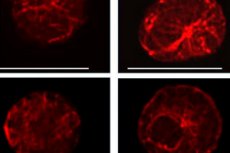
杜克-新加坡国立大学医学院的科学家们发现了人体接触花生、海鲜、花粉或尘螨等过敏原后,一系列反应是如何发生的。他们的研究成果发表在《自然免疫学》杂志上,有望推动预防严重过敏反应的药物研发。
肥大细胞是一种免疫细胞,它会将花生或尘螨等无害物质误认为威胁,并释放出第一波生物活性化学物质来对抗这种感知到的威胁。肥大细胞位于皮下、血管周围以及呼吸道和胃肠道内壁,当它们同时将其预先储存的生物活性物质释放到血液中时,可能会立即引发全身性休克,如果不迅速干预,可能会致命。
根据世界卫生组织 (WHO) 的数据,全球超过 10% 的人口患有食物过敏。随着过敏病例的增加,食物过敏和哮喘的发病率也随之上升。在新加坡,五分之一的儿童患有哮喘,而食物过敏已成为过敏性休克的主要原因。
杜克大学-新加坡国立大学的研究小组发现,含有生物活性化学物质的肥大细胞颗粒的释放是由一种叫做炎症小体的细胞内多蛋白复合物的两个组成部分控制的。到目前为止,人们只知道这些炎症小体蛋白会在免疫细胞中自发组装,分泌可溶性化学物质,当检测到感染时,这些化学物质会向免疫系统的其他部分发出警报。
杜克大学病理学名誉教授索曼·亚伯拉罕(Soman Abraham)在参与杜克-新加坡国立大学新发传染病项目期间领导了这项研究,他表示:“我们发现炎症小体的组成部分在将肥大细胞颗粒(通常堆积在细胞中心)运输到细胞表面并释放的过程中发挥着至关重要的作用。这一意外发现为我们提供了一个精准的干预靶点,从而阻止肥大细胞引发的一系列导致过敏性休克的连锁反应。”
亚伯拉罕教授和他的团队观察了缺乏两种炎症小体蛋白(NLRP3 或 ASC)之一的小鼠。当这些动物接触过敏原时,它们并没有出现过敏性休克。
然而,当肥大细胞中的 NLRP3 和 ASC 蛋白组装并与单个细胞内颗粒结合时,观察到过敏性休克,形成研究人员称之为颗粒体的复合物,它促进颗粒沿着肥大细胞内细胞骨架形成的轨道移动,就像它们“附着在火车轨道上”一样。
论文第一合著者、杜克-新加坡国立大学新发传染病项目首席研究员 Pradeep Bist 博士表示:“当肥大细胞被激活时,我们观察到颗粒沿着被称为微管的动态通路快速移动到细胞膜,然后立即从细胞中释放出来。然而,在缺乏 NLRP3 或 ASC 蛋白的肥大细胞中,我们没有发现颗粒在细胞内移动的证据,而且这些颗粒也没有被释放出来。”
在证明了 NLRP3 和 ASC 在颗粒运输中的作用后,研究小组转向已知的炎症小体抑制剂,看看它们是否可以阻止这一事件。
他们使用一种与慢性炎症疾病临床试验中所使用的药物非常相似的炎症小体阻断药物CY-09,在小鼠接触过敏原之前对其进行了治疗。他们发现,在临床前模型中,这种药物能够有效地预防过敏性休克。
上海交通大学医学院免疫治疗研究所的 Andrea Mencarelli 博士是该论文的第一共同作者,他在杜克-新加坡国立大学新发传染病项目中工作时说道:“值得注意的是,通过使用一种专门阻断炎症小体蛋白活性的药物,我们能够选择性地阻断预先储存的肥大细胞化学物质的释放,而不会影响其他潜在有益的肥大细胞功能。”
虽然这并不能治愈过敏,但它可以为严重过敏症患者提供一种新的方法来预防潜在的危险反应。目前,紧急治疗是在出现首个症状后立即进行的。这些治疗必须在很短的时间内完成才能有效,而且副作用也很严重。
“我明白,当严重食物过敏儿童的父母面临无法确定是否存在接触风险的情况时,这能让他们安心。虽然我们不想长时间抑制免疫系统的这一功能,但它或许能提供短期保护,”亚伯拉罕教授说道。他的团队目前正在优化该药物的剂量和使用频率,以达到最佳的过敏性休克保护效果。
“此后,我们希望对哮喘和过敏性皮肤反应也采取同样的措施。”
杜克-新加坡国立大学研究高级副院长Patrick Tan教授表示:“这一突破具有巨大的转化潜力,不仅代表着进一步研究的范式转变,也代表着改善严重过敏反应风险人群生活质量的范式转变。这为那些长期生活在焦虑中的幼儿家长带来了一线希望。”

